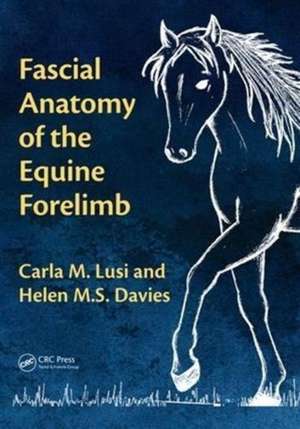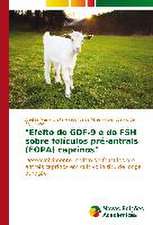Fascial Anatomy of the Equine Forelimb
Autor Carla M. Lusi, Helen M.S. Daviesen Limba Engleză Paperback – 5 iul 2018
The first of its kind in equine anatomy, this clear, concise anatomical guide illustrates the fascial (soft connective tissue) connections of the equine forelimb. Based on dissections of fresh equine cadaver limbs, it provides a visual map for equine physical therapists, veterinarians and horse riders, helping them to understand how pathologies, injuries, or movement abnormalities of the equine forelimb arise and/or progress from one area of the limb to another.
The fascial system is one of the primary systems acted upon by equine physiotherapists and is of increasing interest to horse riders looking to achieve structural integration and balanced movement in their horse. With this in mind, key points in each chapter highlight everyday situations in which knowledge of the fascial system may assist in understanding horse movement and injury.
This practically applicable anatomical atlas is the ideal reference for horse owners, body workers and veterinarians alike.
Preț: 426.81 lei
Preț vechi: 551.99 lei
-23% Nou
81.67€ • 85.50$ • 67.58£
Carte tipărită la comandă
Livrare economică 07-21 aprilie
Specificații
ISBN-10: 0815387385
Pagini: 186
Ilustrații: 15 Line drawings, color; 189 Halftones, color
Dimensiuni: 178 x 254 x 12 mm
Greutate: 0.4 kg
Ediția:1
Editura: CRC Press
Colecția CRC Press
Public țintă
Professional Practice & DevelopmentCuprins
Notă biografică
Helen MS Davies (BAgSci. MAgrSc. BVSc. PhD) is Associate Professor in Veterinary Anatomy, The University of Melbourne. Previously primary author on three anatomy chapters in “Equine Podiatry” (publ. Saunders 2007) and coauthored a chapter on hoof biomechanics in “Equine Laminitis” (publ. Wiley 2016 ). Extensive experience in the following aspects relevant to this proposal; teaching veterinary locomotory and regional anatomy to veterinary students and post graduate courses in physiotherapy and other associated professions (25 years); equine biomechanical and anatomical research (25 years); training horses and riders in all disciplines (40 years); treating and advising trainers and riders on the prevention and management of musculoskeletal conditions (25 years); measuring the development of changes in forelimb loading in young horses in training (25 years).
Recenzii
The images in the book were obtained during dissections of fresh equine cadaver limbs. They are very clear and each structure is labelled to increase reader understanding. Furthermore, each image is reflected and explained in the text. Due to the vast number of images, this book is very easy to follow and understand, and would be ideal for a student wanting to go into more depth with their equine anatomical studies, and also qualified veterinarians allowing a greater understanding for how the normal fascia should look and function, and how it is affected by pathology, injuries and other abnormalities of the equine forelimb.
In addition, the authors have made the text understandable allowing it to appeal to others in the industry, for example, equine physiotherapists or even horse-owners and riders wishing to increase their knowledge about their horse and any potential injuries or abnormalities they may have suffered. I do not believe the book goes into enough detail to provide a well-rounded education on the anatomy, structure and function of the fascial system of the forelimb, and for this purpose would have to be supplemented by another textbook. However, it is a great reference book, allowing readers to quickly research a structure. It has a very well-structured contents page, allowing quick reference for anyone who needs it.
In conclusion, Lusi and Davies have provided an excellent reference resource for students and graduates alike. The number of well-defined, relevant and clear images allow quick understanding for anyone interested in the fascial anatomy of the horse. This small book is perfect to have in your handbag, without causing back-problems, allowing the student or clinician to find all the information they need on-site.
- Sophie Neasham, final year veterinary student, University of Veterinary Medicine in Kosice, Slovakia
Descriere
The first of its kind in equine anatomy, this clear, concise anatomical guide illustrates the fascial (soft connective tissue) connections of the equine forelimb. Based on dissections of fresh equine cadaver limbs, it provides a visual map for equine physical therapists, veterinarians and horse riders, helping them to understand how pathologies, injuries, or movement abnormalities of the equine forelimb arise and/or progress from one area of the limb to another.
The fascial system is one of the primary systems acted upon by equine physiotherapists and is of increasing interest to horse riders looking to achieve structural integration and balanced movement in their horse. With this in mind, key points in each chapter highlight everyday situations in which knowledge of the fascial system may assist in understanding horse movement and injury.
This practically applicable anatomical atlas is the ideal reference for horse owners, body workers and veterinarians alike.










